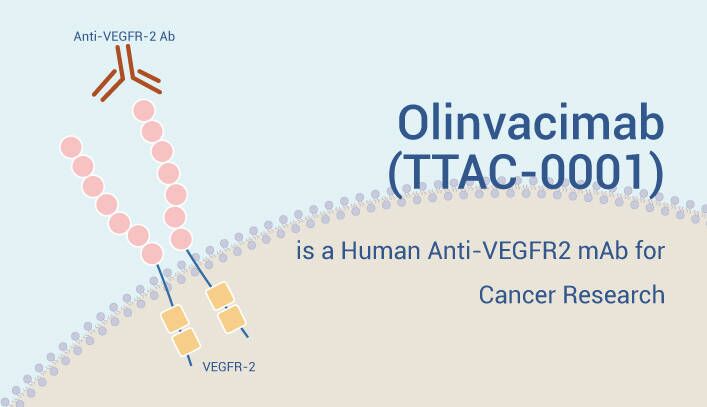Olinvacimab (TTAC-0001) is a fully human anti-VEGFR2 monoclonal antibody from a fully human naive single-chain variable fragment phage library. Olinvacimab (TTAC-0001) inhibits VEGF and binds to KDR with a Kd value of 0.23 nM. Additionally, Olinvacimab (TTAC-0001) (0-1000 nM) inhibits the binding of VEGF to its receptor KDR with a Kd value of 0.23 nM. Olinvacimab (TTAC-0001) inhibits VEGF-165, VEGF-C, and VEGF-D binding to VEGFR-2 with IC50 values of 8.7, 6.3, and 7.0 nM, respectively.
Olinvacimab (TTAC-0001) inhibits the phosphorylation of VEGFR-2/KDR and ERK.

TTAC-0001 also inhibited the phosphorylation of downstream signaling such as ERK. During tumor angiogenesis, VEGF plays an important role. It induces endothelial cell proliferation, migration, and capillary tube formation. As a result, it leads to a dynamic remodeling process of vessel formation. Olinvacimab (TTAC-0001) (1, 15, and 20 mg/mL; 30 min) inhibits VEGF-induced proliferation of HUVEC. Besides, Olinvacimab (TTAC-0001) (20 mg/mL; 30 min) inhibits VEGF-stimulated HUVEC migration. Furthermore, Olinvacimab (TTAC-0001) (5, 10, and 20 μg) dose-dependently inhibits tube formation and disorders tubular structures.
Olinvacimab (TTAC-0001) (1 and 20 μg; 6 d) inhibits hVEGF165-induced rat aortic ring vessel sprouting. Segments of rat aorta embedded in Matrigels containing hVEGF165 developed well-formed vascular sprouts. TTAC-0001 inhibited the numbers and outgrowth of sprouts from the rat aorta induced by VEGF. Additionally, in a matrigel-implanted model in nude mice, the presence of 100 ng hVEGF165 shows dark red color. And this indicates the assembly of red blood cells and neovascularization.
Olinvacimab (TTAC-0001) is a monoclonal antibody targeting VEGFR-2/KDR. Additionally, it strongly blocked multiple functional angiogenesis processes in vitro, ex vivo, and in vivo.
All in all, Olinvacimab (TTAC-0001) has anti-angiogenic activity. Olinvacimab (TTAC-0001) can be used for the research of recurrent glioblastoma and breast cancer.
Reference:
Lee WS, et al. MAbs. 2015;7(5):957-68.